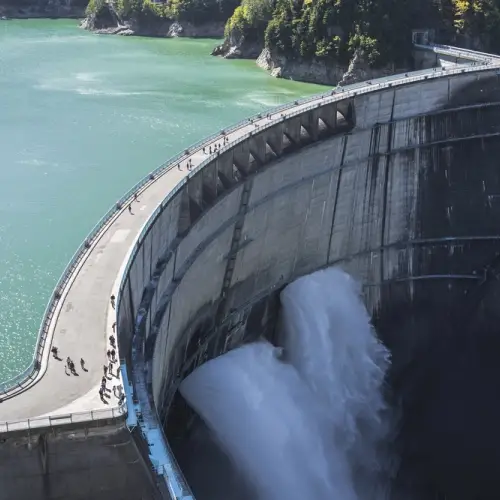
Dynamic electricity is a type of electricity that involves the movement of electrical charges through a conductor.
This form of electricity is also known as electric current and is essential to the operation of modern technology, from lighting a light bulb to running large industrial systems and generating power from renewable sources such as solar energy.
Fundamentals of dynamic electricity
 Dynamic electricity is based on the continuous flow of electrical charges, mainly electrons, through a conductive material.
Dynamic electricity is based on the continuous flow of electrical charges, mainly electrons, through a conductive material.
This flow is generated when a potential difference is established between two points in a circuit, creating an electric field that drives the electrons to move.
Dynamic electricity production
The generation of dynamic electricity occurs mainly through the phenomenon of the electromagnetic effect , where the interaction between a magnetic field and a moving conductor induces an electric current.
This principle is the basis of devices such as electric generators, which convert mechanical energy into electrical energy; electric motors, which transform electricity into mechanical movement; and transformers, which modify the voltage of an electric current to adapt it to different uses.
10 Examples of Dynamic Electricity
To better understand how dynamic electricity works in everyday life, let's look at some examples:
1. Hydroelectric generation
 In a hydroelectric power plant, moving water drives turbines connected to electric generators, converting mechanical energy into electrical energy.
In a hydroelectric power plant, moving water drives turbines connected to electric generators, converting mechanical energy into electrical energy.
This method is one of the most common forms of electricity production in the world, taking advantage of the potential energy of water stored in reservoirs to generate electricity without emitting polluting gases.
2. Operation of an electric motor
In household appliances such as fans or washing machines, electric motors convert electricity into mechanical energy to turn a shaft.
This is achieved through the interaction of magnetic fields in the motor, allowing mechanical parts to be moved efficiently and with low energy consumption.
3. Charging and discharging a battery
 During charging of a battery, electrons are stored in the form of chemical energy.
During charging of a battery, electrons are stored in the form of chemical energy.
This energy is released when the battery powers an electrical device, allowing it to operate without being connected to a continuous power source. This process is essential in mobile technology, electric vehicles and backup power systems.
4. Wind power generation
Wind turbines convert the kinetic energy of wind into electricity by spinning turbines connected to electric generators.
This method of energy generation is sustainable and renewable, with minimal environmental impact and a great capacity to produce electricity in areas with constant winds.
5. Solar energy generation
 Solar panels convert the sun's energy into electricity using photovoltaic cells, which generate direct current from sunlight.
Solar panels convert the sun's energy into electricity using photovoltaic cells, which generate direct current from sunlight.
This form of energy generation is becoming increasingly popular due to its low maintenance costs and its contribution to reducing carbon emissions in the atmosphere.
6. Energy transformers
Transformers adjust the voltage of the electric current to make it compatible with different devices and distribution networks.
Without these devices, it would be impossible to transport electricity over long distances without large energy losses.
7. Electric trains and trams
These means of transport are powered by electric motors that are fed by dynamic electricity. Their use is key to sustainable mobility, as they reduce dependence on fossil fuels and decrease emissions of polluting gases in cities.
8. Lightning during a storm
Lightning is a natural manifestation of dynamic electricity, where large potential differences in the atmosphere generate high-energy electron discharges.
These discharges can reach extremely high temperatures and cause damage to infrastructure and living beings if appropriate protection measures are not taken.
9. Appliances and electronic devices
Most of the appliances we use every day, such as refrigerators, microwaves and televisions, are powered by dynamic electricity. In these devices, the electric current powers electronic circuits and internal motors that allow them to function correctly.
Without dynamic electricity, modern life as we know it would not be possible.
10 Electric fences and security systems
Electric fences use dynamic electricity to generate pulses of current that deter animals or people from crossing them. In security systems, electric current is used in alarms, electronic locks and surveillance cameras, allowing the protection of homes and businesses through the automation of electrical devices.
Movement of electrical charges
Electrical charges can be positive or negative, although in most cases, the electric flow is composed of free electrons (negative charge). In a conductive material, such as copper, electrons can easily move from one atom to another when an electrical potential difference is applied.
When an atom loses electrons, it becomes positively charged and attracts new electrons from neighboring atoms. In this way, the electrons flow in an orderly motion, generating an electric current through the circuit.
Types of electric current
There are two main types of electric current whose main characteristics are the following:
Direct current (DC)
- It flows in one direction constantly.
- It is the current generated by batteries and solar cells.
- It is used in electronic devices and energy storage systems.
Alternating current (AC)
- It changes direction periodically (usually 50 or 60 times per second, depending on the country).
- It is the current supplied through the electrical grid.
- It is used in most industrial and domestic systems due to its ease of transport and conversion.
Explanatory example of the types of currents
 Solar energy is an excellent example to understand when each one is used. Let's look at it in detail:
Solar energy is an excellent example to understand when each one is used. Let's look at it in detail:
Photovoltaic solar panels generate direct current (DC) by directly converting sunlight into electricity without changing the direction of electron flow. This type of current is ideal for powering electronic devices, batteries, and stand-alone systems such as solar street lights or mobile phone chargers.
However, most household appliances and the power grid use alternating current (AC), which requires an inverter to convert DC to AC before it can be used in a home or industry.
Alternating current (AC) is used in electrical distribution because it can be transported over long distances with less energy loss. In a grid-tied solar power installation, the panels generate DC, but an inverter transforms it into AC so it can be used in the home or sold to the electric company.